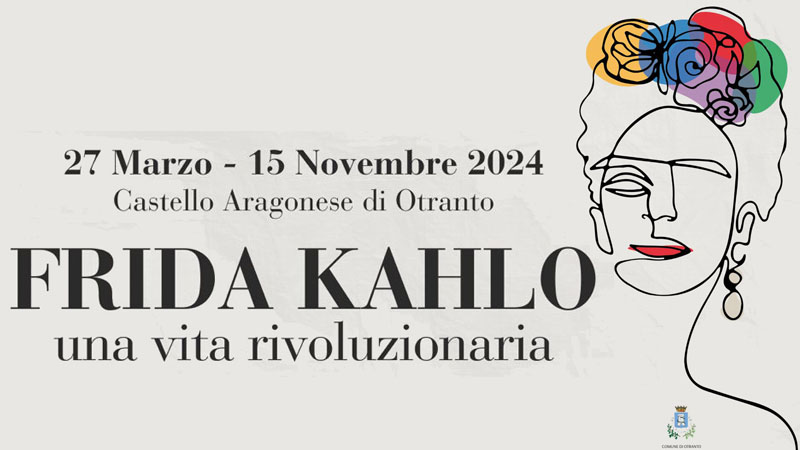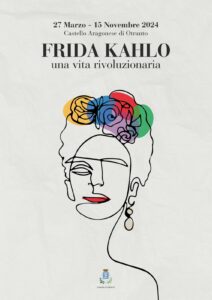Frida Kahlo: A Revolutionary Life An Unmissable Exhibition
From March 28 to November 15, 2024, the doors of the Aragonese Castle of Otranto will open to welcome one of the most anticipated exhibitions of the year: “Frida Kahlo: A Revolutionary Life.” Promoted by the Municipality of Otranto, in collaboration with Art Book Web and 3seizero, this exhibition represents a unique opportunity to explore the universe of one of the most influential artists of the 20th century.

An Iconic Artist
Frida Kahlo, born in Mexico City on July 6, 1907, is one of the most emblematic figures in 20th-century art. Her life, marked by tragic events and intense passions, profoundly influenced her works, which reflect deep introspection and a strong sense of cultural identity. Of mixed origins, with a German father and a Mexican mother, Frida fused the influences of her cultural roots in her works, creating a unique and recognizable style. Her art, characterized by a mix of grand painting and naïve style, is heavily influenced by Mexican folk traditions, from ancient pre-Columbian cultures to the popular practices of her time. Frida’s self-portraits, which make up a significant part of her artistic production, exemplify how she used art to express her physical and emotional pain, her turbulent relationships, and her relentless search for identity. Her paintings, often raw and intense, have been described as an open window to her soul, offering an unfiltered view of her troubled existence. Frida was also a prominent figure in the surrealist movement, though she herself rejected the label, preferring to consider herself simply a realist who painted her reality. Her life was filled with significant events, including a devastating car accident that caused severe physical damage, numerous surgeries, and an intense and tumultuous relationship with the famous muralist Diego Rivera. All these elements contributed to creating a powerful and iconic imagery, making Frida Kahlo a revolutionary figure not only in art but also in visual culture and female imagery.

Exhibition Path
The exhibition “Frida Kahlo: A Revolutionary Life” at the Aragonese Castle of Otranto offers a chronological journey that retraces the artist’s life and work through a series of photographs taken by some of the greatest photographers of the time. Among them are Guillermo Kahlo, Frida’s father, who documented her childhood and youth, and world-renowned photographers such as Edward Weston, Lucienne Bloch, Nickolas Muray, Leo Matiz, and Manuel Alvarez Bravo. The exhibition path is designed to immerse you completely in Frida’s life through images that reveal the most intimate and significant moments of her existence. It starts with family relationships, with photos depicting Frida as a child and young woman, and moves on to her romantic relationships, with images capturing the intensity of her bond with Diego Rivera. The path also includes photographs documenting her intellectual and political encounters, offering a comprehensive look at the influences that shaped her artistic vision. The displayed images not only show Frida’s personal and artistic growth but also her deep connections with Mexican culture and history. Each photograph is accompanied by explanatory texts that provide context and insights, helping visitors better understand the complexity of Frida Kahlo’s life and art. This visual journey will reveal a different, more intimate and personal Frida Kahlo than the one known through her paintings.
Photographs by Guillermo Kahlo
One of the most fascinating aspects of the exhibition is the photographs taken by Frida’s father, Guillermo Kahlo. Born in Germany and moved to Mexico, Guillermo was a professional photographer who greatly influenced his daughter’s artistic formation. His photographs offer a unique glimpse into Frida’s childhood and youth, showing her in moments of everyday life and family intimacy. Guillermo’s shots also document the difficult period following the polio attack that struck Frida at the age of six, leaving her with a crippled right leg. These images reveal Frida’s strength and resilience from a young age, highlighting her deep bond with her father, who encouraged her to express her emotions through art. The exhibition presents these photographs as valuable testimony to how the family environment and paternal support helped shape Frida’s personality and artistic vision.

Intimate Photographs
Alongside the more well-known images, the exhibition features a group of small intimate photographs of Frida, taken in Polaroid format by gallery owner Julien Levy. These photos offer a rare and personal glimpse into Frida’s daily life, capturing moments of spontaneity and vulnerability. The photographic documentation of the famous Casa Azul, Frida’s residence in Mexico City, adds another layer of depth to the exhibition. The intimate photographs portray Frida in her private spaces, surrounded by objects she loved and often depicted in her paintings. These images show a less formal, more relaxed and playful Frida, allowing visitors to get to know the artist beyond her public image. The documentation of Casa Azul offers a glimpse into Frida’s domestic life, revealing details about the environments that inspired many of her works.
Diego Rivera: A Turbulent Love
Another central theme of the exhibition is the intense and often turbulent relationship between Frida Kahlo and Diego Rivera, one of the most famous Mexican artists of the 20th century. Their relationship, characterized by deep love and ongoing tensions, had a significant impact on both their lives and art. The photographs displayed in the exhibition show moments of complicity and artistic collaboration, but also of conflict and suffering. Diego Rivera, known for his murals that decorate public buildings throughout Mexico, was a highly talented and charismatic artist. His relationship with Frida was marked by numerous highs and lows, betrayals, and reconciliations. Despite the difficulties, their bond produced intense artistic and intellectual collaboration, enriching the work of both. The exhibition explores how this complex relationship influenced Frida’s artistic production, highlighting Diego’s role as both muse and life companion.
Relationship with Illness 
Frida Kahlo’s life was marked by continuous health problems that deeply influenced her art and worldview. At just six years old, she was struck by polio, a disease that left her right leg shorter and weaker. This experience, though painful, tempered her character, making her resilient and determined. The tragic car accident of 1925, in which Frida was severely injured, marked a turning point in her life. The injuries forced her to undergo numerous surgeries and spend long periods immobilized in bed. During these times, Frida found escape and a means to express her pain through painting. The exhibition explores how these traumatic experiences shaped her art, making her a symbol of strength and endurance. Her paintings, often raw and intense, reflect her physical and emotional suffering, offering an unfiltered view of her daily struggle against illness.
An Example of Resistance and Courage
In a historical period where issues of femicide and patriarchy are sadly current, the exhibition at the Aragonese Castle pays tribute to Frida Kahlo as an example of resistance and courage. Frida was a pioneer in asserting her identity and artistic vision in a male-dominated cultural system. Her ability to freely express her visions and uphold her personality in such an oppressive context makes her a figure more relevant than ever. The exhibition emphasizes how Frida used her art to challenge the social and cultural norms of her time, exploring themes such as gender identity, sexuality, and politics. Her life and work continue to inspire generations of women and artists, offering a powerful example of how art can be a means of resistance and transformation. Frida Kahlo not only revolutionized the art world but also left an indelible mark in the fight for women’s rights and equality.
Exhibition Details
The exhibition “Frida Kahlo: A Revolutionary Life” will be open on the following days and times:
- From March 28 to May 31 and from September 30 to November 15: 10 AM – 1 PM and 3 PM – 6 PM.
- Saturdays, Sundays, and holidays: 10 AM – 8 PM.
- From June 1 to June 30 and from September 16 to September 19: 10 AM – 10 PM.
- From July 1 to September 15: 10 AM – 12 AM. For ticket and reservation information, you can contact 0832.212745.
The exhibition “Frida Kahlo: A Revolutionary Life” at the Aragonese Castle of Otranto is a must-see event for all art and culture enthusiasts. It invites you to discover the life of one of the most iconic artists of the 20th century through a journey filled with emotions and reflections. Don’t miss the opportunity to immerse yourself in Frida Kahlo’s universe and be inspired by her extraordinary courage and artistic vision.

FAQ Frida Kahlo: A Revolutionary Life
What are the dates of the exhibition? The exhibition “Frida Kahlo: A Revolutionary Life” will be open from March 28 to November 15, 2024.
Where will the exhibition take place? The exhibition will be held at the Aragonese Castle in Otranto.
What are the visiting hours? Visiting hours vary depending on the period: from March 28 to May 31 and from September 30 to November 15, 10 AM – 1 PM and 3 PM – 6 PM; Saturdays, Sundays, and holidays, 10 AM – 8 PM; from June 1 to June 30 and from September 16 to September 19, 10 AM – 10 PM; from July 1 to September 15, 10 AM – 12 AM.
How can I book tickets? For ticket and reservation information, you can contact 0832.212745.
What makes this exhibition unique? The exhibition offers an in-depth journey into Frida Kahlo’s life through rare and precious photographs, documenting key moments of her existence and her personal and artistic relationships.
Who are the photographers whose works are exhibited? Among the photographers who captured Frida Kahlo are Guillermo Kahlo, Edward Weston, Lucienne Bloch, Nickolas Muray, Leo Matiz, and Manuel Alvarez Bravo.
Why is Frida Kahlo considered a cultural icon? Frida Kahlo is considered an icon for her ability to express her personality and artistic vision in a male-dominated cultural context and for her courage in facing life’s adversities.

